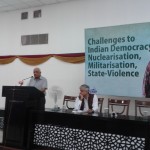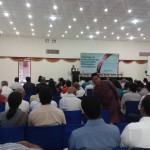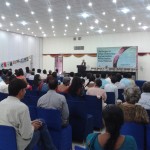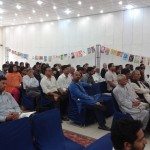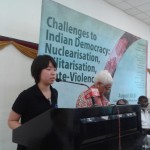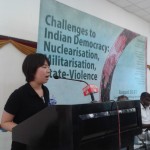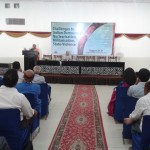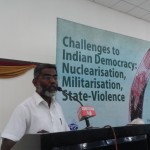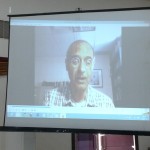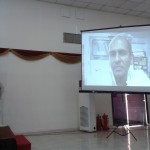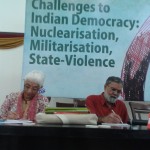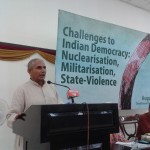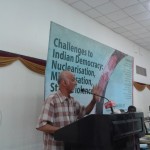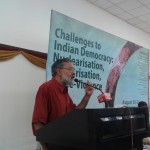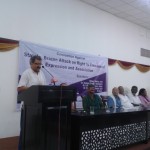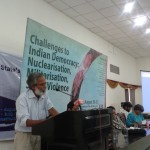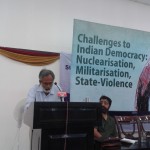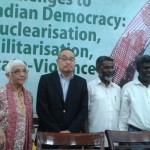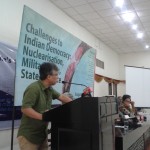Report of the 2-day national Convention organised in New Delhi
August 30-31st, 2014
Organised by:
Coalition for Nuclear Disarmament and Peace(CNDP)
Popular Education and Action Centre(PEACE)
Indian Social Action Forum(INSAF)
National Alliance of People’s Movement(NAPM)
NoMore Campaign
People’s Movement Against Nuclear Energy(PMANE)
International Campaign to Abolish Nuclear Weapons(ICAN)
Prominent activists, journalists and intellectuals like P.Sainath, Medha Patkar, Admiral Ramdas, Praful Bidwai, Jean Dreze, S.P. Udayakumar and other concerned citizens and movements from all over the country converged in New Delhi to raise their voice for justice and peace, and discuss the ways ahead to confront the intensifying assaults on the basic tenets of India’s hard-fought democracy. The convention focused on nuclearisation, militarisation and state violence which are the most immediate and dangerous challenges to Indian democracy.
The convention began with the opening plenary chaired by Admiral L. Ramdas, the [a?] former Chief of the Indian Navy, and a founder member of CNDP, renowned for his support to democratic movements across the country. He stated that the purpose of the seminar is to discuss the present challenges and carve out an agreed perspective which actvists and intellectuals could agree to and start working on immediately. Emphasizing the purpose of the seminar he said that the political shift to right not only in India but all over the world has further led to apprehensions about the rise of nuclearisation, militarization and state violence. Focus of nations throughout the world has shifted to money making. In such times he believes we have the watchdogs’ responsibility that if we find something wrong we must be bold enough to raise our voice.
P. Sainath discussed how media generally deals with nuclearisation and nuclear disasters. When the March 2011 Fukushima disaster occurred, undermining the seriousness of the disaster, the main discussion on the Indian national media was rather on why this sort of disaster can never happen in India as India’s technology is very advanced. He traced the history of the role of media in covering Hiroshima and Nagasaki, when all the news about the bombings and the textbook history was based on one press release from the White House Press Office which celebrated the bombing and marveled at the progress of science and technology. New York Times was contracted by the US government to sell the bomb. Journalist William Lawrence of New York Times, who almost wrote poetry about the bomb was given the Pulitzer Prize for “objective reporting” along with ironically a medal from the war department for services rendered by him. Th myth that the Americans bombed Hiroshima in order to end the war was cleverly marketed as also the second lie regarding the selection of Nagasaki as a target. The actual truth was that they were anxious to test both the uranium and the plutonium bombs – and achieved these objectives.
In stark contrast, An Australian journalist, Wilfred Burchett who raised questions about the disaster caused by the bombings was denied a passport and died as a victim of Hiroshima without even the citizenship of his own country.
Journalism he [Sainath ]believes has been reduced to two categories; one of the stenographers and increasingly now corporate stenographers who obediently just take dictation and the other of real journalists like Wilfred Burchett. He closed with the grim reminder that this marked the beginning of the “semantics of propaganda of the nuclear age”
Medha Patkar talked about the effect that nuclearisation, militarization and state violence is having on the ground realities. These wars she said are not only happening on far away borders but in every village, every river and every seashore of this country in the name of democracy, now even more strenuously than ever. The language of development is used to silence any dissenting voices and these internal divisions caused by such violent onslaughts are ignored to forcefully thrust forward the idea of one India and one vision. The only hope she believes is to fight back with non-violence and research and write about these issues like P. Sainath , Admiral Ramdas and others have been doing. Medha was able to brilliantly draw the links between the roti-kapda-makaan – and jal jangal and jameen concerns – with the unbridled corporatisation and the growing violence seen in the assault on food security, agriculture and industrialization, water, energy and more. All of these are examples of the combined expression of the power and spread of nuclearisation, Militarisation and State Violence.
The next session chaired by Lalita Ramdas – a feminist activist and founder member/chair of Greenpeace India, discussed Nuclearisation: The case against weapons and energy. In this session, Praful Bidwai talked about how nuclear power has failed the promise of being safe, manageable and abundant. Sixty years ago the American President had called it “atoms for peace” and sixty years after, today Nuclear power contributes to less than 4% of total global energy needs and 2% to India’s electricity needs after all the heavy investment. Countries like China have also slowed down their nuclear expansion policies whereas India is bent on expanding it. He believes that contrary to popular beliefs nuclear is not the technology of future, whereas renewable sources of energy are doing much better now and more investment should be made in this sector.
S.P. Udayakumar said that nuclearisation, militarization and state violence are not just challenges to democracy but these are also the reasons why we still remain poor. The undemocratic, anti-people state looks at these as sources of development and people like him who are defending themselves are seen as waging war against the state. The crux of the matter he said is that this “Nuclear Nirvana” is not about the people’s salvation but is about creating profit for French, American, Australian and other industries. Interaction with political parties, he has come to believe is helpless as there seems to be no awareness on the nuclear issue. He hoped to come with further action plan after the two day long convention.
M.V. Ramana, associate professor at Princeton University talked about the aspect of Nuclear energy out of the two aspects of Nuclearization ie. Energy and weapons that are distinct yet related. International reactions post Fukushima disaster has been of three types; some countries like Germany and Switzerland have abandoned Nuclear power, whereas countries like India, China and US remain loyal to nuclear power; however the public popular sentiment in some countries has been against nuclear power due to which countries like Italy and France had to abandon their nuclear projects. He also talked about the controversial Indian Nuclear liability bill that caps the amount that victims are to be paid by the operator and not the supplier in case of a nuclear accident, as US private companies were opposed to selling nuclear reactors until this act was passed. This shows that the neither the private companies nor the government itself is sure about the safety of the reactors.
Zia Mian, a renowned Pakistani physicist based in the Princeton university talked about nuclear weaponisation in Pakistan and its connection with Pakistan’s larger issues. Rivalry with India has pushed Pakistan to take aid from China and US to expand its military and nuclear capacity. It has taken decisions without thinking about the consequences and will not be able to turn the tide of nuclear weapons in near future. It is developing short range, including battlefield, missiles which can be fitted with nuclear weapons. With India going full steam ahead with developing a nuclear weapons triage on land, air and sea , Pakistan will react similarly and a de-stabilising South Asian nuclear arms race is very much on.
Professor Achin Vanaik argued that Nuclear weaponization is also a fundamentally moral [ethical?] problem. He emphasized the importance of international community and specially the south Asian region in the struggle against nuclearisation. The US, he said, is now developing a shield against the nuclear weapons which is even more dangerous as Russia and China feel the need to overload it. India will seek to developing a bigger and sronger arsenal to counter China’s additions which in turn will push Pakistan to build bigger megatonnage and more of nuclear bombs. India itself is creating a shield for Delhi. These efforts, he said, must be opposed internationally and countries indulging in this nuclear warfare must be called nuclear criminals which is the effort of movements like ICAN in calling for a global ban on the use, deployment , transfer and stockpiling of such weapons., it is important for non-nuclear states to be united on this front he believes. Criminalising nuclear weapons becomes a key step in publicly declaring nuclear weapons states guilty of criminal behavior. The logic here is that you first make something illegal so as to then succeed in eliminating that evil. Winning a global moral battle against the possession and use of nuclear weapons is a key part of the process of eliminating any man-made evil. In this respect he quoted Nelson Mandela who was asked when did he know that the battle against apartheid would be won? Mandela said, “we knew were going to defeat Apartheid when we realized that we had captured the moral imagination of enough people.”
The Chair Lalita Ramdas in her closing remarks, pointed out that the nuclear issue is a Womens issue, a Reproductive Rights issue, an Environmental Justice issue, a climate justice issue, a labour rights issue, a peace and security issue and a basic democracy issue and hence it is important to create the space and incorporate -nuclearisation and militarization concerns into all of our movements and struggles. struggle.
The next session was on Combating Militarisation in South Asia which was chaired by Reetika Khera, an economist from IIT Delhi. Jean Dreze took the discussion forward to militarization from nuclearisation. Starting with P Sainath he said that the real villains involved in World War II and
bombings of Hiroshima and Nagasaki must be the men who were happy with such inhuman destruction but there were also people who were not concerned with ethics and only doing their job under the escalating dynamic of war. He talked about his surprise on encountering an article “Ethics of using drones” which on the one hand recognized the Geneva Convention of not killing civilians but stated that it is the responsibility of people who are combatting the onslaught to make themselves visible as innocents. He agreed with the important role of Ethics and morality in this respect but said that if one looks at the issue from the point of view of Reason and Enlightenment, one would reach the same position. He proposed two different interpretations of pacifism as opposed to Militarization; one position is Absolutist which is Gandhian and believes that all violence is wrong, which he feels is a difficult position to sustain and the other is Abolitionist which states that violence may not be always wrong but violence can and should be progressively eliminated from the human experience as it doesn’t belong in a civilized society. Militarisation dismisses us opponents by saying we are sentimental but Dreze emphasized that this position is not only on the side of ethics but also on the side of reason.
Sociologist Pradeep Jaganathan from Sri Lanka briefly traced the genealogy of how the Sri Lankan state got militarized. He said the Sri Lankan state was initially invested in the education system and took steps to secure the people of Sri Lanka in the 1950s after independence. Teaching was seen as an important area for upward mobility of the poor people. However as the majority Sinhalese started opposing the minority communities, the state had to resort to militarization as a response to violent acts by the youth and now the situation has been overturned and the national budget invests more on soldiers than teachers. It has now become increasingly difficult to demilitarize as among other things besides state militarization civil society hostilities has increased the tendencies to riots and violence.
Sabika Zehra, a student from JNU looked at the definition of Militarisation as a phenomenon rather than a state, as a continuum from less militarization to more militarization rather than as an end product. She also looked at makers of militarization and different manifestations of it from the economic, cultural, political, feminist and sociological perspectives.
Day II: State Violence
On the second day of the national convention, an array of speakers – intellectuals, civil society activists, lawyers and grassroots activists spoke at the convention. Apart from two sessions in the morning and the afternoon, an open session for suggesting ideas for the coming months at the end of the second day also saw active participation.
PANEL I – The first session began with Subhash Gatade’s presentation in which he gave an overview of the forces and tendencies engulfing Indian democracy. The Indian state’s siding with corporate interests and its deepening communalisation, caste and gender prejudices require an urgent and sustained intervention. Aditya Nigam underscored the widening gulf between the claims of the nation state and the stark realities in which people lead their daily lives. The nation is reproduced by brutal and increasingly marginalising practices for the majority of people. Prof. Hameeda Bano and Prof. Bimol Akoijam presented a detailed narrative of the Indian state’s violent and discriminatory attitude towards people in Kashmir and the North-east respectively. While these regions are brandished as an inalienable part f the country and any questioning of heavily militarised state presence is termed as anti-national, the real taste of such nationalism has to be borne by common people in these areas where the Indian government has provided legal impunity to the armed forces to kill and rape people at its will. The continued hunger strike by Irom Sharmila for last 14 years is a grim reminder of the deeply problematic relation that the self-proclaimed democracy of India has with the North-East. Prof. Bimol Akoijam talked about Indian nationalism being hegemonised by the north Indian upper caste male image and spoke about the recent misrepresentation of the Manipur boxer Mary Kom in a Bollywood film, usurping her story of the real alienation that she faced for being a Manipuri.
Amar Kanwar talked about the increasing assaults on freedom of speech in India. Nakul Sawhney showed a trailor of his upcoming documentary film on Muzaffarnagar. The first session was chaired by eminent human rights activist Kavita Srivastava.
In the second session, chaired by Kavita Krishnan, lawyer Vrinda Grover spoke about the human rights and communal violence cases that she has been handling for decades, which only push the victims into the endless tunnel of legal struggles. Reliable and swift justice to the mariginalised communities has become almost inaccessible and trvtifying this should be an urgent concern for any joint struggle to protect the democratic values in the country. Nandini Sundar spoke about the ongoing killing of innocent adivasis in the name of confronting Maoism in the areas where actually strong vested interests of mining corporates are calling the shots. The new government has shown all signs of intensifying this indiscriminate and inhuman war on the tribals of India. Dr. Binayak Sen spoke about access to health and nutrition as fundamental democratic rights and underlined the systemic challenges of erosion of this basic promise of post-independence Indian state. Systemic denial of access to food and chronic malnutrition – especially of millions of children – is tantamount to violence by a callous state.
Important observations and interventions were made during the conventions by eminent intellectuals and activists like Dayamani Barla, Dr. Sunilam, Ilina Sen and others.
At the end of the convention, the participants discussed the initiatives to be undertaken in the near and medium term to raise public awareness on the issue of democracy and to bring all the ongoing struggles closer.
Some of the key points agreed upon were:
The need to build the widest possible joint platform of resistance against increasing state violence, blatant disregard for people and nature, growing militarization and nuclearisation, as also the ugly rise of bigotry, communalisation and all forms of intolerance. This should be done by mobilization of diverse groups and movements working on Democracy, Human Rights, Women and Gender, Adivasi and Dalit issues, those fighting against coal, large hydel, nuclear and other energy sources, all renewable and clean energy groups, ecological, environmental groups, from across the country.
Towards the above the following were suggested:
a) A sustained dialogue and concrete planning among the movement groups working on various issues, on the overarching theme of safeguarding democracy
b) Organising similar conventions at the regional level to bring together various people’s strugglesand do so particularly in areas where significant people’s struggles and movements already exist.
c) An urgent and concerted campaign to demand an end to the ongoing fictitious[false?] cases against activists engaged in people’s movements
d) Collaborative efforts in preparing material highlighting the challenges of nuclearisation, militarisation and state violence, particularly in regional languages.

